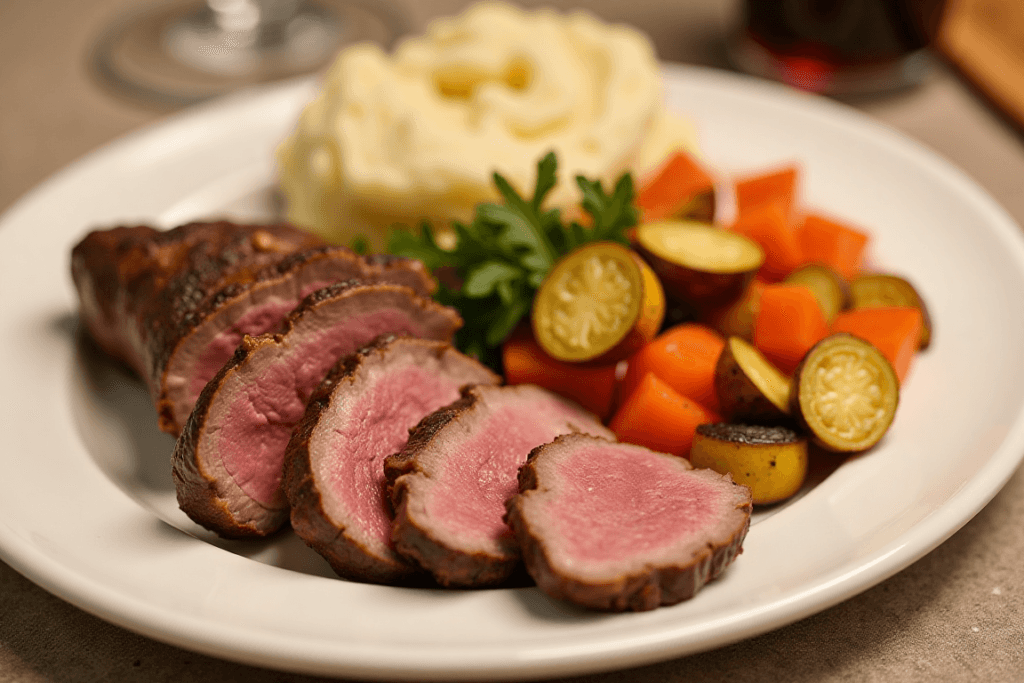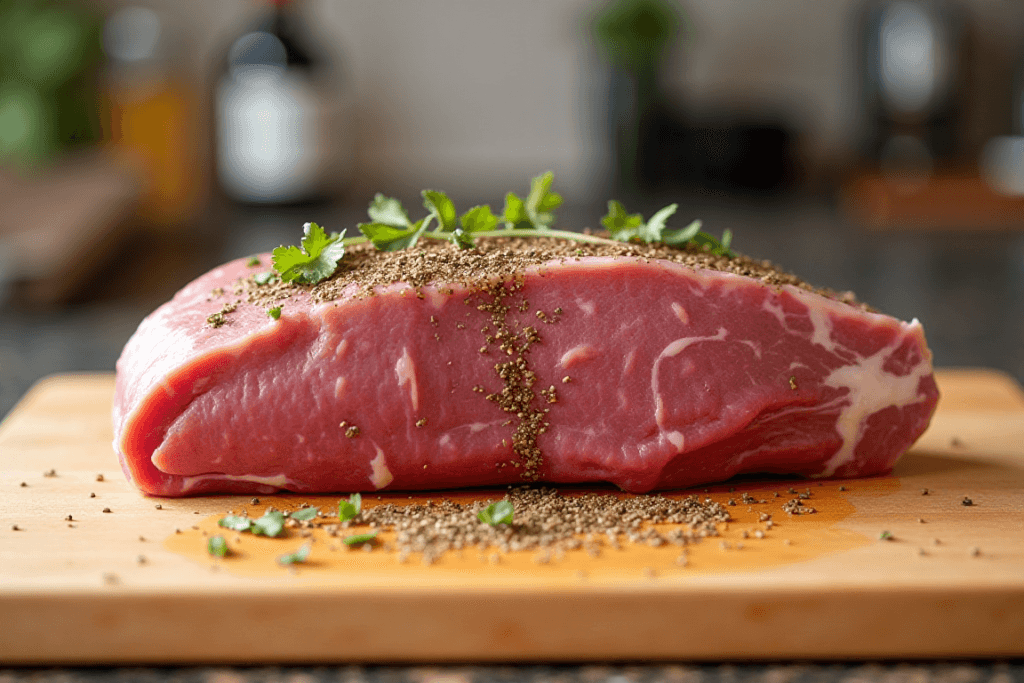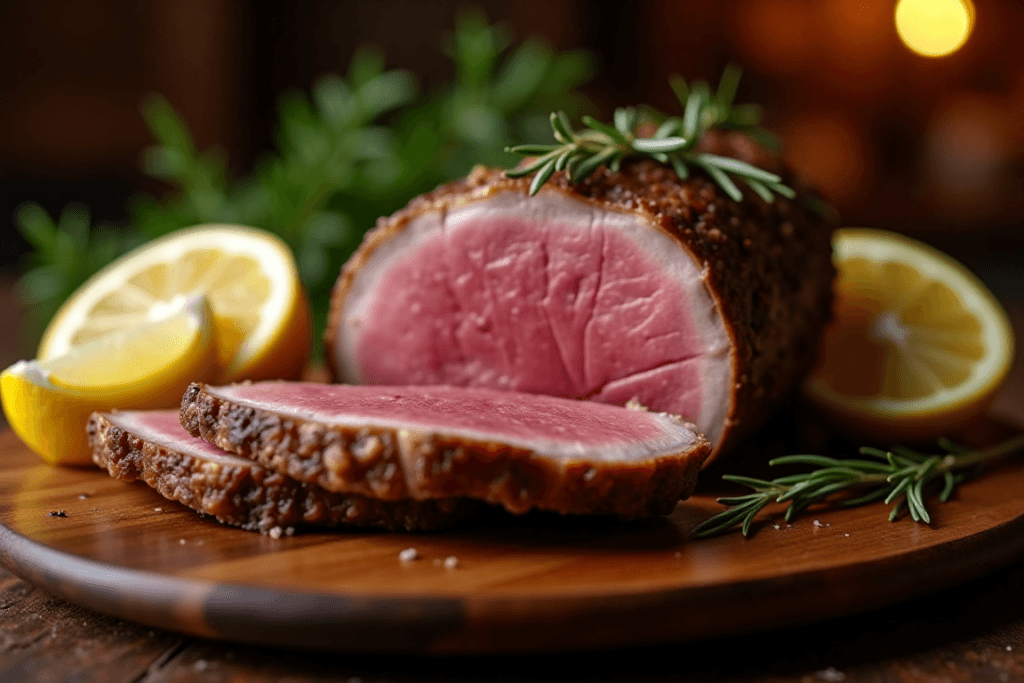
Introduction
The lamb loin roast is a culinary masterpiece, cherished in kitchens worldwide for its unparalleled flavor, tenderness, and versatility. Whether you’re preparing an elegant dinner for guests or a comforting family meal, this cut of lamb is an excellent choice for any occasion. In particular, its rich taste and juicy texture make it a standout centerpiece for holiday feasts or Sunday roasts.
Furthermore, beyond its flavor, this roast offers a delightful culinary challenge. While it is simple to cook, mastering the techniques ensures an exquisite result every time. As we’ll explore in this guide, you’ll learn everything from selecting the perfect cut to pairing it with ideal sides, empowering you to craft a memorable dining experience.
What is Lamb Loin Roast?
This premium cut of lamb comes from the loin section, situated between the rib and leg. Known for its tenderness and rich flavor, it’s often called the “filet mignon” of lamb. Notably, it’s loved by both chefs and home cooks for consistently delivering exceptional taste and texture with minimal effort. As a result, it has become a popular choice for a wide variety of dishes.
Characteristics of Lamb Loin Roast
This premium lamb cut is recognized for its cylindrical shape and is available in both bone-in and boneless options. Specifically, the bone-in variety enhances flavor during cooking and adds a classic presentation, while the boneless version is more convenient for carving and serving. Its fine marbling ensures the meat remains juicy and tender when prepared properly.
Moreover, this roast is smaller compared to other cuts, typically weighing between 1 and 3 pounds. Its manageable size makes it perfect for smaller gatherings or intimate meals. Despite its compact form, it delivers incredible flavor and richness with every bite.
How It Differs from Other Lamb Cuts
What sets this roast apart from other cuts of lamb is its balance of tenderness and taste. Unlike tougher portions, such as the shoulder or leg, which require slow cooking, the loin is naturally tender and cooks much faster. Additionally, its flavor is milder compared to the more robust taste of lamb shank, making it a great choice for those new to lamb dishes.
In addition to its superior texture, this cut is versatile and works well with various cooking methods. From oven roasting to grilling, its adaptability and premium quality make it a popular choice for both casual meals and elegant occasions.
Popular Uses and Occasions for Lamb Loin Roast
This roast is a favorite for special events and holidays such as Easter, Christmas, and New Year’s celebrations. Its versatility also extends to pairing with a variety of marinades, herbs, and seasonings, making it suitable for diverse cuisines, including Mediterranean, Middle Eastern, French, and British styles.
Whether featured as the centerpiece of a festive feast or enjoyed as a comforting weeknight meal, this roast adds sophistication to any dining experience. Ultimately, its rich flavor and tender texture ensure it’s always a crowd-pleaser.
Why Choose Lamb Loin Roast?
This exceptional lamb cut is celebrated for its rich flavor, tenderness, and versatility. A favorite among home cooks and chefs alike, it offers a simple way to craft a truly memorable meal. If you’re seeking a dish that’s both elegant and delicious, this roast is a perfect choice for your table.
Flavor and Tenderness
This lamb cut offers a flavor that is both robust and refined. Often described as earthy, slightly sweet, and mildly grassy, it’s ideal for those who enjoy rich, savory dishes. Its fine marbling ensures the meat remains juicy, delivering a soft, melt-in-your-mouth texture..
Unlike tougher cuts like the shoulder or leg, this roast cooks quickly and retains its tenderness with minimal effort. It’s an excellent choice for anyone looking for a luxurious dish without spending too much time in the kitchen. Whether you’re a novice or a seasoned pro, this lamb cut is a dependable option for an impressive main course.
Health Benefits of Lamb Loin Roast
Lamb loin roast isn’t just delicious—it’s also packed with essential nutrients. This cut of lamb is an excellent source of high-quality protein, which is vital for muscle growth and repair. It’s also rich in vitamins and minerals that promote overall health, including:
| Nutrient | Health Benefit |
|---|---|
| Iron | Maintains healthy red blood cells and prevents anemia. |
| Zinc | Boosts immune function and supports wound healing. |
| Vitamin B12 | Enhances energy production and supports brain and nerve health. |
| Omega-3 | Promotes heart health and reduces inflammation. |
Compared to beef, lamb offers higher levels of omega-3 fatty acids, which are known to benefit heart health. If you’re looking for a nutrient-dense meat to include in your diet, lamb loin roast is an excellent choice.
Versatility in Cooking Lamb Loin Roast
One of the greatest strengths of lamb loin roast is its versatility. This cut adapts beautifully to a wide range of cooking methods and flavors. Whether you enjoy bold spices or simple seasoning, lamb loin roast can handle it all.
Some popular preparation styles include:
- Mediterranean: Marinate with olive oil, garlic, lemon, and fresh herbs like oregano or thyme.
- Middle Eastern: Season with cumin, coriander, and cinnamon for a warm, spiced flavor.
- French-Inspired: Coat the roast in Dijon mustard, breadcrumbs, and fresh parsley for a classic twist.
- Asian-Inspired: Use a marinade of soy sauce, ginger, garlic, and sesame oil for an aromatic dish.
Lamb loin roast also pairs well with a variety of side dishes. From creamy mashed potatoes to roasted vegetables, the possibilities are endless. Pair it with a vibrant salad or a tangy mint sauce for a complete and balanced meal.
A Dish for Every Occasion
Whether it’s a holiday celebration or a cozy weeknight dinner, lamb loin roast fits any occasion. Its manageable size makes it perfect for small gatherings or intimate meals. Plus, it’s easy to prepare while still delivering a gourmet dining experience.
By choosing lamb loin roast, you’re investing in a dish that’s as versatile as it is delicious. Its tender texture, rich flavor, and health benefits make it a standout choice for your next meal. Give it a try and savor the exceptional taste of lamb loin roast.
Preparing Lamb Loin Roast the Right Way

Proper preparation is the key to unlocking the full potential of lamb loin roast. From selecting the right cut to seasoning it perfectly, attention to detail ensures a dish that’s both flavorful and tender.
Selecting the Best Cut
Choosing the right lamb loin roast is the first step toward a successful meal. Here are some tips to guide your selection:
- Freshness: Look for meat with a vibrant pinkish-red hue and fine, creamy-white marbling. Avoid cuts with a grayish tint or excess liquid in the packaging.
- Bone-in vs. Boneless: Decide based on your cooking preference. Bone-in roasts offer richer flavor, while boneless options are easier to carve and serve.
- Ask Your Butcher: Don’t hesitate to ask for a custom cut or specific portion size to fit your recipe or group size.
Trimming and Prepping Lamb Loin Roast for Cooking
Lamb loin roast typically comes with a layer of fat that can enhance flavor during cooking. However, trimming it slightly may be necessary to prevent excessive grease. Use a sharp knife to remove any large, hard portions of fat, leaving a thin layer for flavor.
If your roast is boneless, consider tying it with butcher’s twine to ensure even cooking and maintain its shape. This is particularly useful for rolled or stuffed roasts.
Marinating for Enhanced Flavor
While lamb loin roast is naturally flavorful, marinating it can elevate its taste even further. Here’s how to create a simple yet effective marinade:
- Basic Ingredients: Combine olive oil, garlic, fresh rosemary, thyme, lemon juice, salt, and pepper.
- Process: Place the roast in a resealable bag or shallow dish and pour the marinade over it, ensuring all sides are coated.
- Timing: Allow the meat to marinate for at least 1-2 hours, or overnight for a deeper infusion of flavors.
For an alternative flavor profile, try a spice rub using cumin, coriander, paprika, and chili flakes for a Middle Eastern touch.
Bringing the Roast to Room Temperature
Before cooking, remove the lamb loin roast from the refrigerator and let it sit at room temperature for 30-60 minutes. This step ensures even cooking, as cold meat can lead to uneven results.
Tools and Equipment
To prepare lamb loin roast successfully, having the right tools can make all the difference. Consider the following essentials:
- Sharp Knife: For trimming and carving.
- Roasting Pan or Baking Dish: To hold the roast securely during cooking.
- Meat Thermometer: Ensures the roast reaches the perfect internal temperature.
- Butcher’s Twine: Useful for securing boneless cuts.
How to Cook Lamb Loin Roast
Cooking lamb loin roast to perfection involves mastering the right techniques and timing. Whether you prefer a classic oven roast or are experimenting with alternative methods like grilling or sous vide, the following steps will guide you to achieve a tender, flavorful result.
Step-by-Step Guide to Roasting Lamb Loin Roast
- Preheat the Oven: Set your oven to 375°F (190°C). A moderate temperature ensures even cooking without drying out the meat.
- Season the Roast: Pat the lamb dry with paper towels, then season generously with salt, pepper, and your chosen herbs or spice rub.
- Optional Searing: For a golden crust, sear the roast in a hot skillet with a bit of oil for 2-3 minutes on each side before transferring it to the oven.
- Roast in the Oven: Place the lamb loin on a rack in a roasting pan. This allows air circulation for even cooking. Roast until the internal temperature reaches your desired doneness (use a meat thermometer for accuracy):
- Medium-rare: 130-135°F (54-57°C)
- Medium: 135-145°F (57-63°C)
- Well-done: 150°F+ (66°C+)
- Rest the Meat: Remove the roast from the oven and let it rest for 10-15 minutes. This allows the juices to redistribute, ensuring a moist and tender texture.
Alternative Ways to Cook Lamb Loin Roast
Grilling:
- Preheat the grill to medium-high heat.
- Season the roast and sear on all sides for 2-3 minutes per side.
- Reduce the heat to medium and continue grilling, turning occasionally, until the desired doneness is achieved.
Sous Vide:
- Vacuum-seal the seasoned lamb loin roast in a plastic bag.
- Cook in a water bath set to your desired doneness temperature (e.g., 130°F for medium-rare) for 1-2 hours.
- Finish with a quick sear in a hot pan for a caramelized crust.
Slow Cooker (For a Twist):
- Add seasoned lamb, onions, garlic, and broth or wine to the slow cooker.
- Cook on low for 6-8 hours for a fall-apart tender result.
Enhancing the Flavor During Cooking
Basting: Periodically spoon the juices from the roasting pan over the meat for added moisture and flavor.
Aromatic Additions: Place garlic cloves, rosemary sprigs, or lemon slices in the roasting pan to infuse the lamb with complementary flavors.

Tips for Perfect Doneness
- Always use a meat thermometer to avoid undercooking or overcooking.
- Remove the roast from the oven slightly before it reaches the desired temperature, as it will continue cooking while resting.
FAQs
What is the best cooking method for lamb ?
The best cooking method for lamb depends on the cut. For tender cuts like lamb loin roast, oven roasting or grilling works beautifully. Tougher cuts, such as shoulder or shank, benefit from slow cooking methods like braising or stewing.
Is lamb healthier than beef ?
Lamb is a nutritious alternative to beef. It contains more omega-3 fatty acids, which are beneficial for heart health. Additionally, lamb is rich in iron, zinc, and vitamin B12. While lamb may be slightly fattier than lean cuts of beef, its fats are often healthier due to its grass-fed diet.
Should you sear lamb before roasting ?
Yes, searing lamb before roasting enhances its flavor and creates a beautiful crust. While not mandatory, this step is highly recommended for adding depth and richness to the dish.
How to cook lamb loin roast ?
Cooking lamb loin roast involves seasoning, optional searing, and roasting at a moderate temperature until the desired doneness is achieved. Let the meat rest after roasting to lock in its juices. For detailed steps, refer to the “How to Cook Lamb Loin Roast” section above.
How to roast lamb loin chops ?
Roasting lamb loin chops is similar to roasting a loin roast. Preheat the oven to 400°F (200°C), season the chops, and sear them in a skillet for 2 minutes per side. Transfer the skillet to the oven and roast for 5-7 minutes, depending on your preferred doneness.
